Tips for Welding Sheet Metal With MIG or TIG
Print Article
Learn why MIG, pulsed MIG, TIG and pulsed TIG are the ideal choices when welding sheet metal.
When welding thin metal, the main objective is to avoid warping, burn-through and excessive heat-affected zones while still ensuring the weld has enough mechanical strength for the application. Short-circuit transfer MIG (short arc), TIG and pulsed TIG welding processes provide the most control over the heat to address these challenges.
Always use the smallest wire diameter possible, since smaller wires take less heat to melt and heat the metal less. Small wires also provide more control over the weld bead and a better chance of recovering from mistakes due to lower deposition rates.
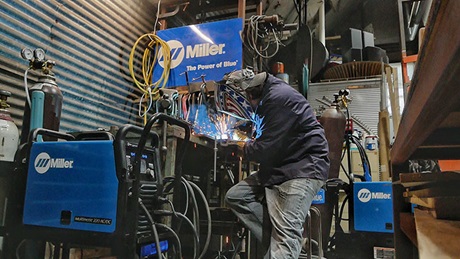
As a rule of thumb, don’t use a filler metal thicker than the base metal. It’s recommended to use a .023- or .024-inch wire for most light gauge sheet metal work. When the material is 18-gauge and thicker, you may be able to use a .030-inch wire. To weld mild steel, choose an American Welding Society classification wire such as ER70S-6, which has a weld puddle that wets out nicely.
Always use a higher argon-based shielding gas, such as 75% argon/25% carbon dioxide. Argon carries less heat than pure CO2, and you’ll experience less spatter.
When welding 304 stainless steel, ER308, ER308L and ER308LSI wires are compatible, but for welding 316L stainless, you need a 316L wire. With these materials, use a tri-mix gas — 90% helium, 8% argon and 2% CO2.
To weld sheet metal with solid wires, use electrode positive (EP, or reverse polarity). Don’t attempt to weld thin materials like sheet metal with flux-cored wires, which put more heat into the base metal.
TIG welding sheet metal
Forget the larger 1/8-inch tungsten electrode and use a smaller one. Ceriated tungsten are preferred, with thoriated tungsten as a second option. The diameters down to .020, .040 and 1/16-inch tungsten are popular. Smaller electrodes start easier and perform better at lower heat settings, which helps prevent burn-through and allows you to better focus the arc in a smaller area. For steels, keep the tungsten pointed, and grind it parallel with the length.
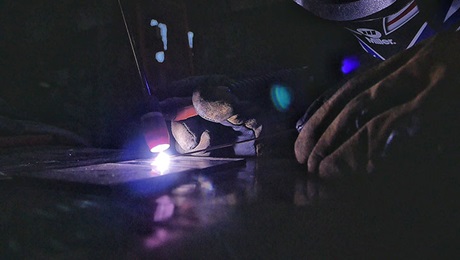
While ER70S-2 filler metal is a common choice for steel, another popular option for welding sheet metal is silicon bronze. It is softer and finishes well, while reducing the heat required to weld it. It’s also important to select a filler metal that is thinner than the base metal, or as close as possible. This ensures you won’t overheat the base metal before the filler metal gets a chance to join with it.
For optimal results on thin aluminum, use an inverter-based power source. While it’s common to weld with a pure tungsten that is balled at the end, with an inverter-based welder, you can use the same ceriated tungsten and prepare it the way you would for steel applications. Compared to the balled pure tungsten used with conventional TIG welders, a pointed electrode provides greater arc control and enables you to direct the arc precisely at the joint to minimize distortion. Typical aluminum alloys for sheet fabrication are 3003 and 5052. Filler metals for either of these would be 4043 or 4943. A 5356 filler metal also works for 5052 materials specifically.
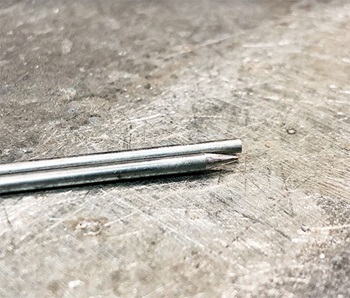

Techniques
To prevent burn-through and warping, don’t whip or weave the torch; the more time the arc is in an area, the hotter it becomes. Always travel in a straight line and use the fastest travel speed possible that maintains a good bead profile. Another way to prevent burn-through is to use a push technique of the MIG gun. This points the wire at the cooler edge of the base metal and puddle compared to pulling the gun, which directs the wire toward the hotter portion of the puddle — increasing chances of a blowout.
Skip welding: Unevenly distributed heat causes distortion and warping, which wreaks havoc on parts that should fit together. To minimize warping, distribute heat as evenly as possible. You can accomplish this by using a skip welding technique, which involves making a series of intermittent or stitch welds.
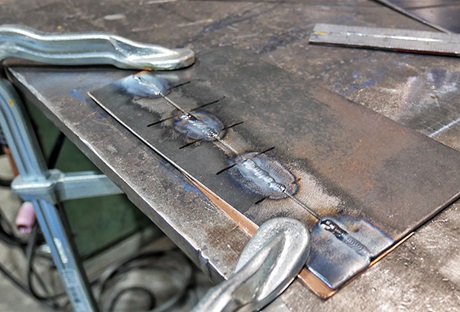
Backing bars: To dissipate heat faster than atmospheric cooling alone, place the heat-affected zone in contact with a backing or chill bar. This can be as simple as a metal bar (usually copper or aluminum because they dissipate heat best) clamped to the back of the weldment.
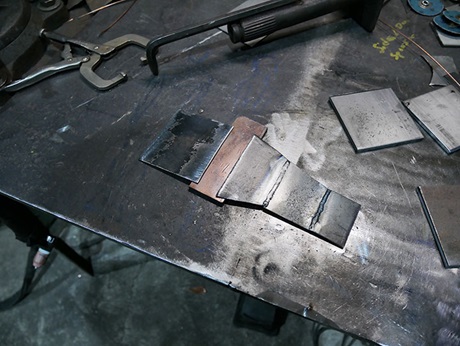
Fit-up and joint design: Welding thin metal demands tight fit-up. Imagine a butt weld on 20- to 24-gauge metal. If the parts fail to touch each other for even 1/16 inch, you have created a hole that invites burn-through and a gap that can’t absorb the heat. To avoid rework, follow the “measure twice, cut once” rule. You can also try to redesign the part with joints that can withstand more heat. You might even be able to utilize a plug weld in areas that don’t require a solid weld bead.
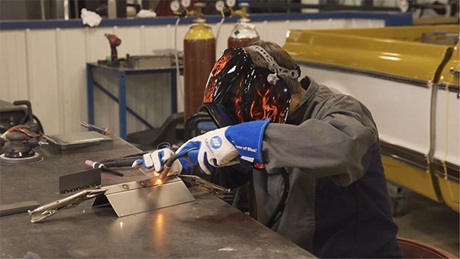
Preventing burn-through and warping when welding sheet metal is all about controlling the heat. Choose the right welding process and filler metal, and follow these common tips to help ensure success.